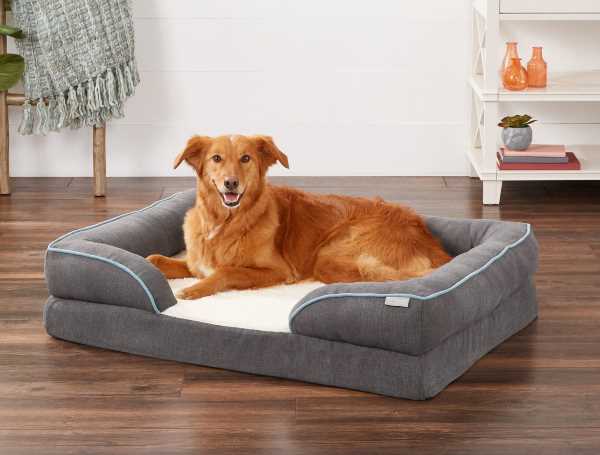Osteoarthritis in dogs or degenerative joint disease, seen in about 20% of older dogs, affects a dog’s spine and joints. Even simple movements like getting up or down, are stiff and painful.
Just as with people, cold damp weather seems to make the symptoms of arthritis in dogs worse.
What is Dog Arthritis?
Osteoarthritis in dogs is a condition that develops over time. If your Weimaraner dog suddenly develops symptoms, he probably does not have arthritis. Symptoms of arthritis typically appear slowly, over a period of months.

Here is how osteoarthritis develops. The joint cartilage, or cushioning in the joints, becomes worn as your dog moves and uses them. As the joints become worn out, they also become inflamed. When they are inflamed, joints start become swollen, painful and they are warm to the touch.
As the arthritis progresses, a dog’s joints become painful and stiff, just as we see in people. Some dogs are simply uncomfortable, while others are seriously disabled.
Eventually, your dog could lose his ability to move freely, or he could actually be paralyzed.
What Happens in Your Dog’s Arthritic Joints?
As arthritis progresses, the cartilage in the joints becomes thinner. In addition, fluid builds up in the affected joints.
Your dog may also have bone spurs or bony growths around a joint. These can irritate other tissues and nerves and they are very painful.
In addition to lameness, a dog can develop thickening and scar tissue in the joint and wasting away of the surrounding muscles.
As these changes happen, the joint becomes even more inflamed, and it continues to break down and destroy cartilage. The more the arthritis progresses, the more disabled a dog becomes because of the stiffness and pain.
Eventually there is enough damage to the joint that you can actually hear a clicking or grating sound when your dog moves.
What Causes Canine Osteoarthritis?
There are several reasons that your Weimaraner may have arthritis:
Hip Dysplasia
Hip dysplasia is a common cause of osteoarthritis in larger dogs like the Weimaraner. Unfortunately larger breeds are more prone to hip and joint problems.
Wear and Tear
The most common cause of osteoarthritis in dogs is simple wear and tear. Most Weimaraners are rough and ready and they work their muscles and bones hard.
Bacteria
There is another form of arthritis that is becoming more common in recent years. Known as infectious or septic arthritis, it is bacterial and it is spread through the blood. This bacteria may enter through a cut or break in the skin. More on septic arthritis below…
Ticks
Your dog can also get this type of arthritis from ticks. If your dog acquired Rocky Mountain Spotted Fever or Lyme Disease from a tick, she could develop arthritis or an arthritis-like condition.
Deer ticks, the ones that carry Lyme disease, are very tiny–the size of the period at the end of this sentence. Because we don’t always find the ticks, your dog could be infected without your knowing it.
Injuries
In addition, dogs can get arthritis from an old injury, especially to the ACL (anterior cruciate ligament).
Diet
A dog can develop arthritis because of a high calorie, high carbohydrate diet that causes her body to grow faster than her cartilage grows.
Symptoms and Treatment of Osteoarthritis in Dogs
If your Weimaraner has the most common kind of arthritis in dogs, osteoarthritis, you may see these symptoms:
- Lameness
- Trouble going up and down stairs
- Difficulty sitting or standing
- Stiff and slow when getting up
- Less interest in playing with you or with his toys
- Less energy for walks or runs
- Swelling of the affected joints
- Wasting away of muscles
- Thickening and scarring of the joint tissues
- Grating or clicking sound when your dog moves the affected joint
- Soft tissue swelling around the joint
- X-rays show fluid in the joint or bone spurs.
Medications for Osteoarthritis
Treatment for osteoarthritis in dogs can be either medications or surgery. When medications are used, NSAIDS are the medication of choice.
However, you do have to be careful when giving nonsteroidal anti-inflammatory drugs to dogs long term, because NSAIDS sometimes cause gastrointestinal problems like loss of appetite, vomiting and inflammation of the stomach and intestines.
Corticosteroids are sometimes used for osteoarthritis and, like NSAIDS, they also cut down on inflammation. They are usually given only for a short time because of their side effects.
Supplements
Cosequin Maximum Strength Joint Supplement with MSM, Glucosamine and Chondroitin has a huge following of pet parents who swear by it. With this supplement, many dogs are almost back to normal, frisky and agile, with little pain and stiffness.
If your dog has arthritis, it’s certainly worth a try.
Surgery for Canine Arthritis
If your dog has surgery, the vet may fuse the joint, replace a joint, cut some of the joint or even amputate one of your dog’s legs.
Ways to Help Your Dog at Home
Other treatments that are more conservative could include:
Weight Reduction
Just like people, overweight dogs put extra stress on their joints. Reducing a dog’s weight will take some of the stress off his joints. Giving your dog a senior dog food for less active dogs will help with this.
Exercise
carefully monitored exercise on soft surfaces like grass. The idea is to keep your dog moving, but gently, so that she doesn’t do further damage to her joints.
Heat
Warm compresses applied to sore joints or a heat pad or heated bed.
Supplements
Glucosamine and chondroitin supplements help keep joints moving and functioning.
Orthopedic Bed
Provide an orthopedic bed for support where your dog sleeps or relaxes. This can help with stiffness and pain, but it won’t eliminate them entirely.
Ramps
You can purchase a ramp for the sofa or bed or a travel ramp that can help your dog get into the truck or car.
Prevent Slips and Falls
Get rid of any throw rugs that do not have a non-slip backing. And provide carpet or another surface that gives your dog a safe, non-slip place to walk from room to room.
In addition, keep your dog’s nails trimmed, so long nails don’t interfere with her walking.
Diagnosis of Canine Osteoarthritis
Since your dog really can’t tell you exactly what is hurting and how much, your vet will depend on you to observe any changes in your dog’s behavior.
Your dog’s veterinarian will use these criteria to diagnose:
- Your dog’s medical history – including any trauma or injuries to his joints
- Physical examination – the vet will check for tenderness, swelling and warmth in the joints
- X-rays
- Blood tests
- MRI
- Lab tests on fluid from the joint
Osteoarthritis is often Confused with Septic Arthritis
There is another cause of arthritis in dogs that is becoming more common in recent years. It is known as infectious or septic arthritis.
Septic arthritis is bacterial and it is spread through the blood or it enters through a cut or break in the skin.
To make things worse for outdoor and sporting dogs, your dog can also get this type of arthritis from ticks. If your dog acquired Rocky Mountain Spotted Fever or Lyme Disease from a tick, she could also develop arthritis.
Symptoms of Septic Arthritis
If your Weimaraner has acquired septic arthritis, either through a wound (or surgery) or from a tick, you will see symptoms like the following:
- Lameness
- Listlessness or lack of interest in normal activities
- Not eating – loss of appetite
- Swelling in one or more joints
- Joint(s) that are affected are warm to the touch
- X-rays reveal fluid in the joint
- Joints are breaking down – degenerative joint disease
Using these tests, your vet will determine if your dog has osteoarthritis or septic arthritis. Or if it is something else.
Septic arthritis or infectious arthritis is treated with antibiotics. If it is discovered early enough, your dog may not have permanent damage to his joints.
However, if septic arthritis has progressed, your dog may need flushing of his joint cavity and surgery to remove dead, damaged or infected tissue in the joint.
No matter which kind of arthritis your dog has, you can be sure that it is painful and uncomfortable.
Early diagnosis is key to helping your dog, and there are some simple things that you can do to make your dog more comfortable, as well.






Leave a Reply